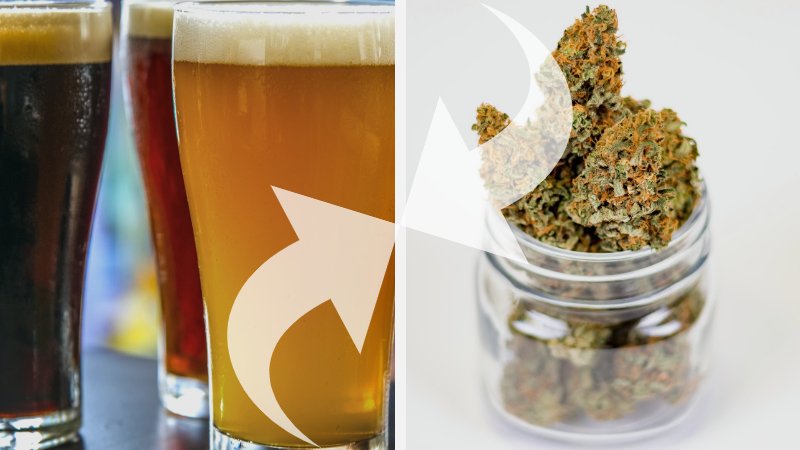With recreational cannabis here to stay, can craft cultivators replicate the successes witnessed across the craft beer industry
The US craft beer industry was worth $26 billion in 2017, and while the explosive growth appears to have dwindled in recent years, the industry is still innovating, creating and pushing the limits of beer into 2018.

Very interestingly, the areas with an established local-brewery culture, are also now the areas working to promote cannabis. Oregon, Colorado, and down the west coast of Canada are some examples with a hot craft beer market, and a growing cannabis one. These places, known for having a brewery in what seems like every small town, may soon have a small-scale grower carving out a similar space for premium recreational strains.
The craft cannabis cultivator is one focused on technique, innovation, and final product. Compared to the big names in the recreational market, whose focus is on quantity and price point, the craft grower goes into the game knowing they will have to charge a premium for the final product.
Gram for gram, there are substantial differences between a nug grown in a crop with less than 200 square meters of canopy versus an industry grower. Canopy Growth Corp, as an example, has close to 250,000 square meters of canopy. It’s like comparing a can of Budweiser to sipping a pint of an interesting sour at Cascade Brewing Barrel House in Portland.
ARE CONSUMERS WILLING TO PAY PREMIUM FOR CRAFT CANNABIS?
It’s fortunate for the cannabis industry as a whole that the hard work of consumer education has already been done regarding “craft,” “micro,” and “artisanal” products. Small-scale growers don’t need to educate the public about what the craft terminology means – the picture is crystal clear for the consumers who matter. “Craft” conveys an image of premium, small batch, and creative.
Perhaps because the landscape was already well established for small production, as well as the associated premium costs for that production process, customers aren’t surprised when they head to the dispensary. According to the latest statistics, the average consumer pays $6.83 per gram in Canada. With recreational cannabis only just launched the price point on premium strains is less clear, although indications from the black market suggest consumers are willing to pay $15 for top shelf flower.
An educated consumer, like within the beer industry, is also willing to pay more for exotic flavors, experiences, and possible medical benefits. A smoother smoke, interesting cannabinoid profile, or novel terpene combinations aren’t going to come from large-scale industrial operations focused on quantity of mainstay strains. Rather, these experiments will start with the micro cultivator.
CHALLENGES TO CRAFT CANNABIS IN CANADA
In Canada, craft cultivators are facing more market challenges than their microbrewery counterparts. The regulation of recreational marketing and branding are unprecedented when compared to the beer and wine industry. Customers overwhelmingly choose books based on their cover; and wine based on their labeling. But in Canada, this is not so with cannabis.
When Canadians shop for weed online, or in person, labels all look the same because of the strict control over marketing, branding, and labeling. Without the marketing budget and media attention of Aurora, Canopy Growth orTilray, it’s hard for the micro cultivator to stand out on the shelf. Brand recognition in Canada is going to be a hard-won battle for the little guys. If the labels all run together, with little to differentiate them on a visual basis, the average consumer may struggle to develop a sense of brand loyalty.
Another challenge is the licensee process in Canada for small growers. When recreational cannabis launched in Canada, the micro-licensee program had not been established. Meaning, these small-batch cultivators were not on industry shelves when Canadians headed to the dispensary during the first weeks of sale.
The Micro Cultivation License, which is now available, gives allowances for growers with under 200 square meters of canopy space. Before, every single grower in Canada had to fill out the same application, with the same licensing fees, as the Aurora’s of the world. It made small production cost prohibitive. Today, the introduction of the Micro Cultivation Licence in Canada has made allowances, financial and otherwise, for small scape and financially-lean operations.
At the end of 2018, this change in regulation came a little too late for small producers to gain an early market share, and the first-mover advantage enjoyed by the big names operating under a Standard License. It remains to be seen how micro-growers make a name for themselves when it’s so challenging to stand out. Given time, a bit of marketing ingenuity, and the underlying consumer demand for premium cannabis, the craft cultivators of the world will likely find ways to make their voice, and brand, known across the country.

